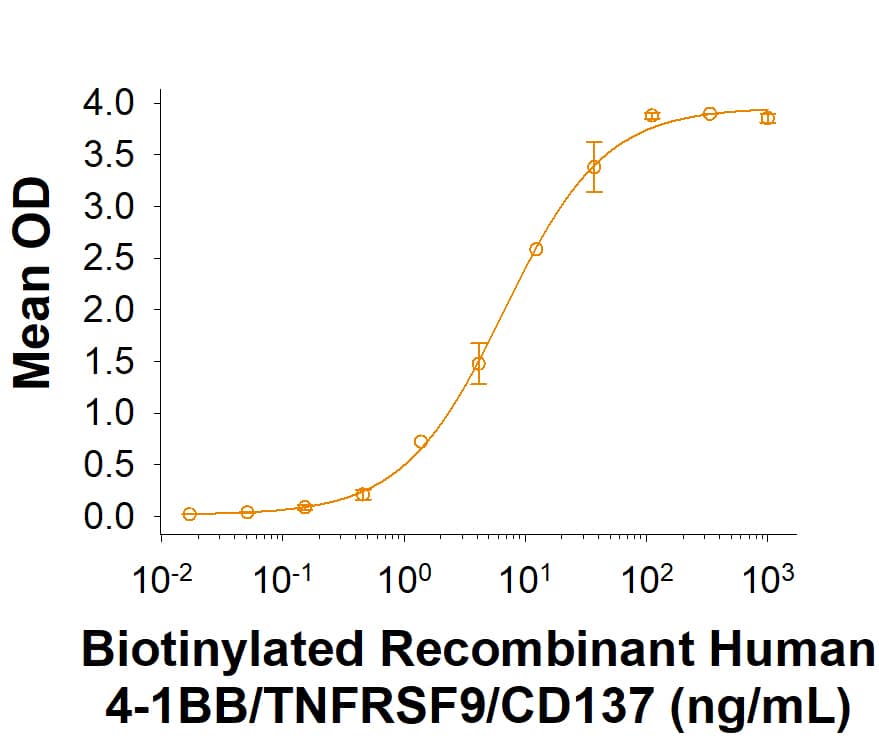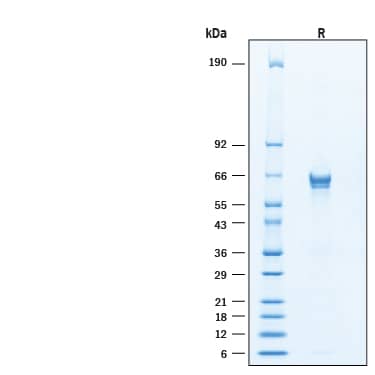Recombinant Human 4-1BB/TNFRSF9 Fc His biotin Protein, CF
Recombinant Human 4-1BB/TNFRSF9 Fc His biotin Protein, CF Summary
- R&D Systems NS0-derived Recombinant Human 4-1BB/TNFRSF9 Fc His biotin Protein (BT838)
- Quality control testing to verify active proteins with lot specific assays by in-house scientists
- All R&D Systems proteins are covered with a 100% guarantee
Product Specifications
| Human 4-1BB (Leu24-Gln186) Accession # Q07011 | DIEGRMD | Human IgG1 (Pro100-Lys330) | 6-His tag |
| N-terminus | C-terminus | ||
Analysis
Product Datasheets
BT838
Carrier Free
CF stands for Carrier Free (CF). We typically add Bovine Serum Albumin (BSA) as a carrier protein to our recombinant proteins. Adding a carrier protein enhances protein stability, increases shelf-life, and allows the recombinant protein to be stored at a more dilute concentration. The carrier free version does not contain BSA.
In general, we advise purchasing the recombinant protein with BSA for use in cell or tissue culture, or as an ELISA standard. In contrast, the carrier free protein is recommended for applications, in which the presence of BSA could interfere.
BT838
| Formulation | Lyophilized from a 0.2 μm filtered solution in PBS with Trehalose. |
| Reconstitution | Reconstitute at 250 μg/mL in water. |
| Shipping | The product is shipped at ambient temperature. Upon receipt, store it immediately at the temperature recommended below. |
| Stability & Storage: | Use a manual defrost freezer and avoid repeated freeze-thaw cycles.
|
Scientific Data
 View Larger
View Larger
Biotinylated Recombinant Human 4-1BB/TNFRSF9/CD137 Fc Chimera His-tag Protein (Catalog # BT838) binds Recombinant Human 4-1BB Ligand/TNFSF9 (2295-4L/CF) with an ED50 of 4.00-60.0 ng/mL.
 View Larger
View Larger
2 μg/lane of Biotinylated Recombinant Human 4‑1BB/TNFRSF9/CD137 Fc Chimera His-tag Protein (Catalog # BT838) was resolved with SDS-PAGE under reducing (R) condition and visualized by Coomassie® Blue staining, showing bands at 52-68 kDa.
Background: 4-1BB/TNFRSF9/CD137
4-1BB, also known as CD137 and TNFRSF9, is an approximately 30 kDa transmembrane glycoprotein in the TNF receptor superfamily. 4-1BB functions in the development and activation of multiple immune cells (1). Mature human 4-1BB consists of a 163 amino acid (aa) extracellular domain (ECD) with four TNFR cysteine‑rich repeats, a 27 aa transmembrane segment, and a 42 aa cytoplasmic domain (2, 3). Within the ECD, human 4-1BB shares 60% aa sequence identity with mouse and rat 4-1BB. 4-1BB is expressed as a disulfide-linked homodimer on various populations of activated T cell including CD4+, CD8+, memory CD8+, NKT, and regulatory T cells (4-7) as well as on myeloid and mast cell progenitors, dendritic cells, mast cells, and bacterially infected osteoblasts (8-11). It binds with high affinity to the transmembrane 4-1BB Ligand/TNFSF9 which is expressed on antigen presenting cells and myeloid progenitor cells (3, 8). This interaction co‑stimulates the proliferation, activation, and/or survival of the 4-1BB expressing cell (3-7). It can also enhance the activation-induced cell death of repetitively stimulated T cells (3). Mice lacking 4-1BB show augmented T cell activation, perhaps due to its absence on regulatory T cells (12). 4-1BB can associate with OX40 on activated T cells, forming a complex that responds to either ligand and inhibits Treg and CD8+ T cell proliferation (13). Reverse signaling through 4-1BB Ligand inhibits the development of dendritic cells, B cells, and osteoclasts (8, 11) but supports mature dendritic cell survival and co‑stimulates the proliferation and activation of mast cells (9, 10).
4‑1BB activation enhances CD8+ T cell and NK cell mediated anti-tumor immunity (14). It also contributes to the development of inflammation in high fat diet-induced metabolic syndrome (15). Soluble forms of 4-1BB and 4-1BB Ligand circulate at elevated levels in the serum of rheumatoid arthritis and hematologic cancer patients, respectively (16, 17).
- Wang, C. et al. (2009) Immunol. Rev. 229:192.
- Schwarz, H. et al. (1993) Gene 134:295.
- Alderson, M.R. et al. (1994) Eur. J. Immunol. 24:2219.
- Wen, T. et al. (2002) J. Immunol. 168:4897.
- Pulle, G. et al. (2006) J. Immunol. 176:2739.
- Zheng, G. et al. (2004) J. Immunol. 173:2428.
- Kim, D. et al. (2008) J. Immunol. 180:2062.
- Lee, S. et al. (2008) Nat. Immunol. 9:917.
- Choi, B.K. et al. (2009) J. Immunol. 182:4107.
- Nishimoto, H. et al. (2005) Blood 106:4241.
- Saito, K. et al. (2004) J. Biol. Chem. 279:13555.
- Lee, S. et al. (2005) J. Immunol. 174:6803.
- Ma, B.Y. et al. (2005) Blood 106:2002.
- Choi, B.K. et al. (2010) J. Immunol. 185:1404.
- Kim, C. et al. (2011) Diabetes 60:3159.
- Michel, J. et al. (1998) Eur. J. Immunol. 28:290.
- Salih, H.R. et al. (2001) J. Immunol. 167:4059.
FAQs
No product specific FAQs exist for this product, however you may
View all Proteins and Enzyme FAQsReviews for Recombinant Human 4-1BB/TNFRSF9 Fc His biotin Protein, CF
There are currently no reviews for this product. Be the first to review Recombinant Human 4-1BB/TNFRSF9 Fc His biotin Protein, CF and earn rewards!
Have you used Recombinant Human 4-1BB/TNFRSF9 Fc His biotin Protein, CF?
Submit a review and receive an Amazon gift card.
$25/€18/£15/$25CAN/¥75 Yuan/¥2500 Yen for a review with an image
$10/€7/£6/$10 CAD/¥70 Yuan/¥1110 Yen for a review without an image

